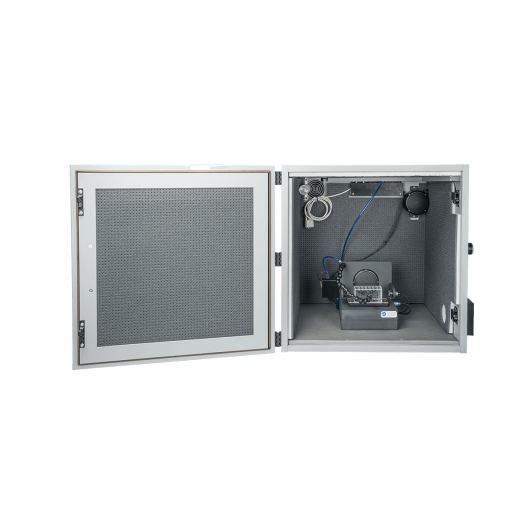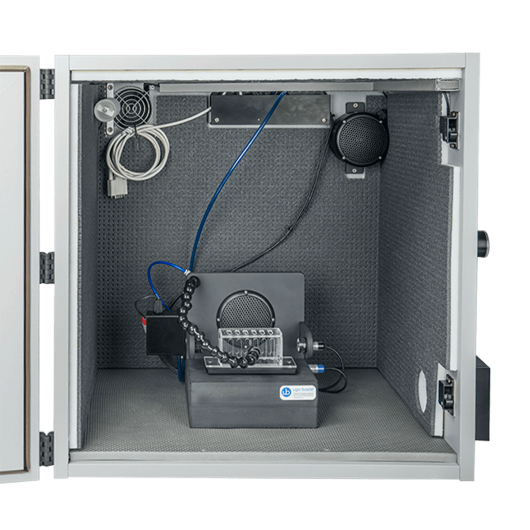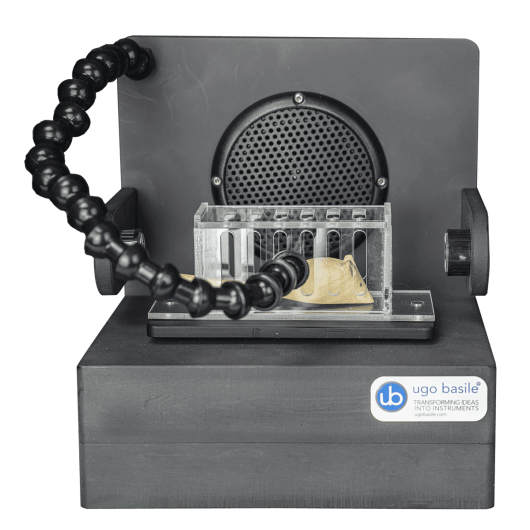


PPI test, startle test multiple-cage set-up for mice
Depending on the number of cages, different set-ups can be obtained by combining a controller with Dedicated Software on board, with a Startle Link-Box and up to 4 Isolation Cubicles and Stimulating/Recording Platforms, each including two different Animal boxes (NO HOLDER). Multiple-cage set-ups require expansion-cubicle/s with slave electronics on board.
On the Controller 12” touch-screen, the operator sets Sound and Light parameters via the user-friendly interface. Trials can be configured by defining trial number, acoustic/visual stimulus and timing of the different experimental sequences (all fully randomizable):
- Pulse
- Prepulse
- Inter-Pulse Interval
- Inter-Stimulus Interval
The Stimulating/Recording Platform is the core of the set-up, encompassing the box where the mouse is placed, the light and the speaker, which deliver the startling stimuli (pulses), and the detection system. Two Mouse Boxes are provided as standard:
- 48000-320 Small Mouse Box: ID 84x34x39(h)mm
- 48000-320 Large Mouse Box: ID 84x39x44(h)mm
A Startle-Link Box collects the signals from up to 4 Stimulating/Recording Platforms and sends them to the Controller.
The new-design Isolation Cubicle 46000-590 includes an I.R. light, a loudspeaker and a noiseless fan, all conveniently positioned inside the sound attenuating box.
Features
- Part of the BEEHIVE SYSTEM
- Maximum Flexibility, full event randomization
- Remote Control feature
- Great Versatility
Application
In animals, including humans, the startle response is a largely unconscious defensive response to sudden or threatening stimuli, such as sudden noise or sharp movement, and is associated with negative effect. Usually the onset of the startle response is a startle reflex reaction, a brainstem reflectory reaction (reflex) that serves to protect vulnerable parts, such as the back of the neck (whole-body startle) and the eyes (eyeblink) and facilitates escape from sudden stimuli.
Prepulse Inhibition (PPI) is a neurological phenomenon in which a weaker prestimulus (prepulse) inhibits the reaction of an organism to a subsequent strong startling stimulus (pulse). The stimuli are usually acoustic, but tactile stimuli (e.g. via air puffs on the skin) and light stimuli are also used.
The reduction of the amplitude of startle reflects the ability of the nervous system to temporarily adapt to a strong sensory stimulus when a preceding weaker signal is given to warn the organism.
Deficits of prepulse inhibition, manifesting in the inability to filter out the unnecessary information, have been linked to abnormalities of sensorimotor gating, noted in patients suffering from illnesses like Schizophrenia and Alzheimer’s Disease, or under the influence of drugs, surgical manipulations, or mutations. Animal models are widely used to test hypotheses linking genetic components of various diseases with sensorimotor gating.
Method paper
- M. Koch: “The Neurobiology of Startle” Prog Neurobiol. 59(2):107-28, 1999
- D. Braff et alia: “Human Studies of Prepulse Inhibition of Startle: Normal Subjects, Patient Groups, and Pharmacological Studies” Psychopharmacology 156(2): 234-258., 2001
- H.S. Hoffman et al.: “Startle Reaction: Modification By Background Acoustic Stimulation” Science 141: 928-30, 1963
- R.R. Marsh et alia: “The Role of Small Changes in the Acoustic Environment in Modifying the Startle Reflex” J Exp Psychol Anim Behav Process, 1(3): 1975



